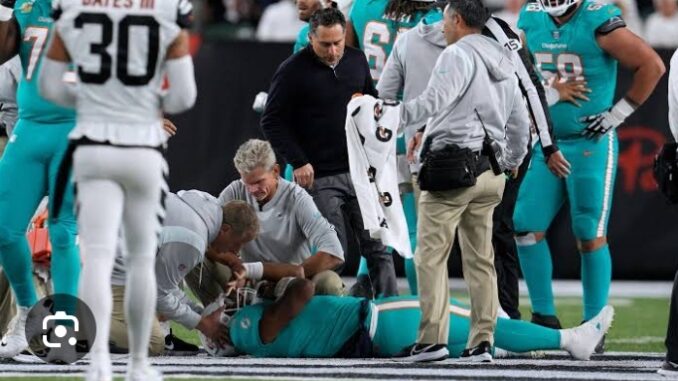
Tua Tagovailoa’s Injury Wasn’t Just a Failure of Protocol
The N.F.L. has amended its rules for allowing players back on the field, and a medical specialist has reportedly been fired, but some of football’s problems aren’t fixable.
Not long after the Miami Dolphins quarterback Tua Tagovailoa was thrown to the ground, with six minutes left in the first half of a matchup against the Cincinnati Bengals, slamming the back of his head into the turf, Joe Burrow, the Bengals quarterback, took the field. By then, the game, which took place on the second-to-last day in September, was an afterthought to many people. Everyone watching on television had seen replay after replay of Tagovailoa’s hands flying up over his face as he rolled onto his back after the hit, his fingers gruesomely splayed—it appeared to be an automatic response known to indicate a serious brain injury. Everyone inside the stadium had seen paramedics place him on a stabilizing board and load him into a stretcher. Everyone knew, after more than a decade of well-publicized research, about the possible long-term effects of brain trauma experienced by N.F.L. players—the higher rates of amyotrophic lateral sclerosis (A.L.S.), of dementia, of mood and personality disorders, of the scourge of chronic traumatic encephalopathy (C.T.E.), a brain disorder brought on by repeated blows to the head.
A decade ago, concussions seemed like an existential threat to football. Even the N.F.L. has been forced to acknowledge the damage done by the sport to the people who played it, settling for a billion dollars with former players who brought concussion-related lawsuits. Spotters were hired to sit in stadiums during games and watch out for players exhibiting signs of concussions; there are now protocols in place to test whether a player has suffered one, and there is a five-phase process that a player needs to follow if he’s diagnosed with one, before he can return to the field. This year, new guidelines required padded helmets during training camp for some players. The number of reported concussions has declined, and the subject has ceased to dominate The impulse after Tagovailoa’s injury, naturally, was to point fingers: the rules must not have been followed properly; the protocol was flawed, or had broken down. Miami’s coach, Mike McDaniel, had been criticized for putting Tagovailoa back into a game after he hit his head on a similar sack and stumbled as he made his way to the huddle. McDaniel had said that Tagovailoa had been evaluated in the locker room and passed all tests, and was simply suffering from a back injury. He had responded hotly to the suggestion that he had put a player in harm’s way, and was anguished by what had happened. “That is not part of the deal that anyone signs up for,” McDaniel said, after Tagovailoa was stretchered off the field, his voice thick with emotion.
Leave a Reply